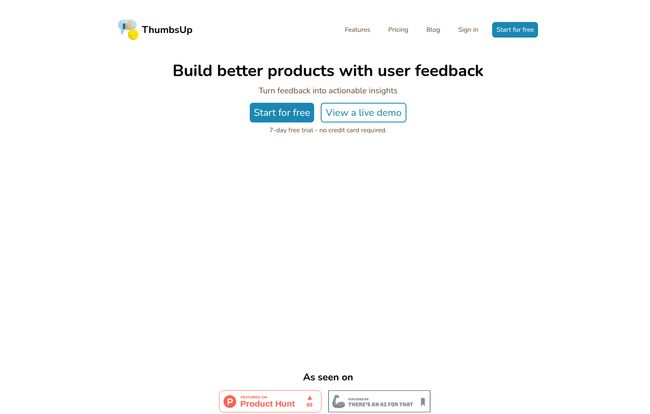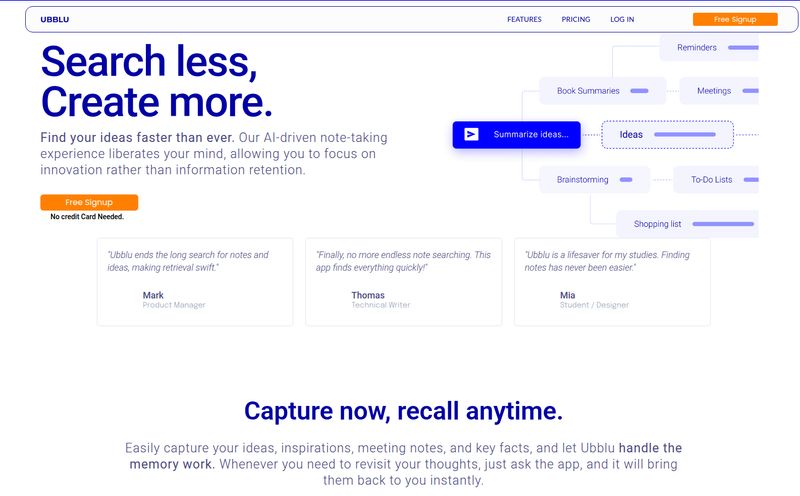If you’ve ever launched a product, an app, or even just a moderately popular blog, you know the feeling. The user feedback starts as a trickle, then becomes a stream, and before you know it, you’re drowning in a firehose of opinions. It’s a chaotic mix of emails, tweets, support tickets, and that one random comment on an old Instagram post. You know there's gold in there, but you’re too busy trying not to drown to actually find it.
For years, my “system” was a horrifyingly complex spreadsheet with color-coding that only made sense to me on a Tuesday. It was a nightmare. So, when a tool like ThumbsUp pops up on my radar—especially one that’s getting some love on Product Hunt—my ears perk up. It promises to not just collect feedback but to make sense of it with AI. A bold claim. But is it just another pretty dashboard, or can it actually tame the feedback beast? I decided to take a look.
What Exactly Is ThumbsUp Anyway?
At its heart, ThumbsUp is a user feedback platform. Simple enough. But its goal isn't just to be a digital suggestion box. It aims to be the central nervous system for your customer voice. The idea is to give your users one dedicated place to praise, complain, report bugs, or suggest that brilliant feature you never thought of. No more hunting through five different channels.
But the real kicker, the thing that separates it from a simple forum, is the layer of intelligence it builds on top. It’s not just about collection; it's about interpretation. It wants to tell you how your users feel and what they’re talking about most, automatically. For a time-strapped founder or a busy product manager, that’s… well, that’s the dream, isn’t it?
The Core Features That Actually Matter
A feature list is just a list. What I care about is how it works in the real world. Here’s my breakdown of what ThumbsUp brings to the table.
A Central Hub for Every User Voice
The foundation of the platform is its dedicated feedback boards. Think of it less like a complaint form and more like a focused, digital town hall. Users can post their thoughts, sure, but they can also see what others are saying, upvote ideas they agree with, and engage in discussions. This is huge. It stops you from getting 50 separate requests for the same thing and instead shows you one idea with 50 upvotes. Instantly, you have a prioritized list of what people really want. It builds a little community around your product development, which is a powerful thing for customer loyalty.
Beyond Words with Sentiment Analysis
Okay, this is where things get interesting. ThumbsUp doesn't just read the words; it tries to read the emotion behind them. Its sentiment analysis scans feedback and tags it as positive, negative, or neutral. Why does this matter? Because “The new update is… different” and “I absolutely hate the new update” might contain similar keywords, but they carry wildly different emotional weight. This feature is like being able to read the room. It helps you quickly gauge the overall mood after a new release or identify the most frustrated users who might need a little extra attention. It’s a shortcut to empathy.
Spotting Wildfires with Keyword Trends
Another really smart feature is the keyword trend report. The platform automatically identifies recurring words and phrases in your feedback over time. Suddenly, you notice the word “slow” or “confusing” or “login error” starting to creep up the charts. This is your early warning system. It allows you to be proactive, to spot a small issue before it becomes a full-blown crisis that has your support team chugging coffee at 2 AM. You can see the smoke before the fire really starts.
Your AI Co-Pilot for Product Decisions
Finally, there are the AI Suggestions. Based on all the feedback and analysis, ThumbsUp will offer data-driven recommendations. Now, I’m always a bit skeptical of AI making creative decisions. But I see this less as an “AI boss” and more as an “AI co-pilot.” It’s not going to build your roadmap for you, but it might say, “Hey, a lot of negative feedback mentions the checkout process. You might want to look at simplifying Step 3.” It’s a fantastic way to overcome personal bias and ensure you’re addressing what the data says is most important.

Visit ThumbsUp
Let's Talk Money: The ThumbsUp Pricing Breakdown
Alright, the part everyone scrolls down to first. The pricing. I was genuinely surprised here, in a good way. The structure is refreshingly simple, and there’s a genuinely useful free tier.
| Plan | Price | Best For | Key Features |
|---|---|---|---|
| Starter | FREE | Solo founders, indie hackers, small projects | Unlimited responses, 1 admin, and you can match your branding. All the basics to get started. |
| Pro | $39 /mo | Growing startups and established teams | Everything in Starter, plus up to 5 admins and the full suite of AI tools: AI suggestions, sentiment reports, and keyword trends. |
My take? The Free plan is incredibly generous. For anyone just starting out, it’s a no-brainer. You get the core feedback collection system without paying a dime. The Pro plan at $39/month feels very reasonable for the value it provides. If your business depends on customer satisfaction, the cost of the AI insights is almost certainly less than the cost of one unhappy customer who churns because you missed their feedback.
The Good, The Not-So-Perfect, and The AI
No tool is perfect, and a review that says so is just an ad. So let's get down to it. I love the comprehensive approach. Having feedback collection, analysis, and trend-spotting all under one roof is a massive workflow improvement. The AI-driven stuff, while not a magic wand, is a powerful lens to focus your attention. It's a huge step up from manual sorting.
However, you have to go in with the right expectations. The AI isn't infallible. Sarcasm or nuanced language can sometimes fool a sentiment analysis algorithm. So, it's a guide, not a gospel. You still need a human to make the final call. Also, the system's value is directly tied to user participation. If your users don't use the feedback board, you won’t get much data. You'll need to actively guide them there. Finally, the real juicy features—the AI reports—are locked behind the Pro plan. That’s fair, but something to be aware of if you’re starting on the free tier.
My Final Take: Is ThumbsUp Worth Your Time?
After digging in, I’m genuinely impressed. ThumbsUp feels like a tool built by people who have actually felt the pain of managing user feedback. It’s thoughtful, focused, and solves a real problem without adding unnecessary complexity.
So, who is this for?
- Indie Hackers & Solopreneurs: Absolutely. Start with the free plan. It will professionalize your feedback process overnight.
- SaaS Companies & Product Teams: Yes. The Pro plan is a small investment for the amount of time and guesswork it can save. It will help you build a more user-centric roadmap.
- Large Enterprises: Maybe. They might have more complex needs or existing systems, but for a specific product team within a larger company, it could be a fantastic, agile solution.
It’s not going to magically build a perfect product for you. But it will give you a much clearer map and a better compass. It turns the chaotic roar of user feedback into a conversation, and in my book, that’s worth a whole lot.
Your ThumbsUp Questions Answered (FAQ)
- 1. How accurate is the AI sentiment analysis?
- It's generally very good for straightforward feedback. Like most AI today, it can struggle with heavy sarcasm or very complex sentences. I'd treat it as a 90% solution that helps you quickly sort the majority of feedback, but always give a final human read to the most critical comments.
- 2. Is the FREE Starter plan enough to be useful?
- Yes, absolutely. It gives you the most important part: a centralized, organized feedback board. You'll miss the advanced analysis, but just having one place to direct users is a huge improvement over chaos. You can always upgrade later as you grow.
- 3. Can I match the feedback board to my website's design?
- Yep! Both the Free and Pro plans allow you to match your branding. This helps create a more integrated experience for your users, so it doesn’t feel like they’re being sent to a generic third-party site.
- 4. How is this different from just using a tool like Canny or UserVoice?
- While they operate in a similar space, ThumbsUp seems to put a stronger emphasis on the integrated AI analysis, like sentiment and keyword trends, right from the get-go. Its pricing is also very competitive, especially for smaller teams and startups who might find other platforms a bit too pricey.
- 5. Do I need to be a developer to set it up?
- No, setting up a feedback board is straightforward. It’s designed to be user-friendly for product managers, marketers, and founders, not just engineers. You can create your board and start collecting feedback pretty quickly.
- 6. Where does the AI get its suggestions from?
- The AI suggestions are generated by analyzing the collected feedback in aggregate. It looks for recurring themes in bug reports, feature requests, and general comments, and then synthesizes that information into actionable recommendations for improvement.



